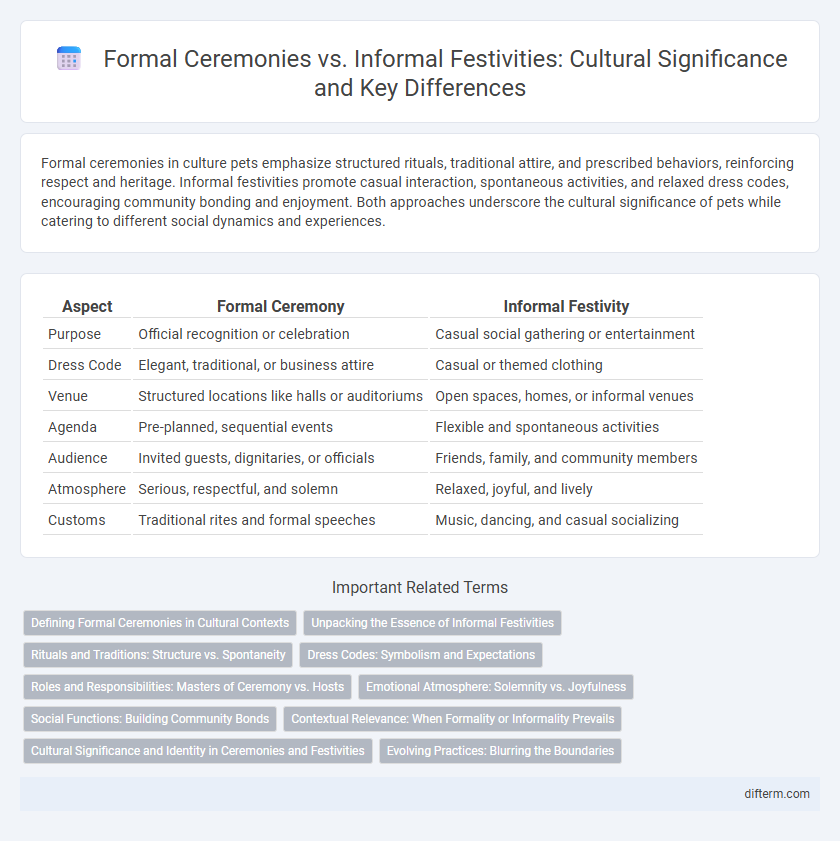Formal ceremonies in culture pets emphasize structured rituals, traditional attire, and prescribed behaviors, reinforcing respect and heritage. Informal festivities promote casual interaction, spontaneous activities, and relaxed dress codes, encouraging community bonding and enjoyment. Both approaches underscore the cultural significance of pets while catering to different social dynamics and experiences.
Table of Comparison
| Aspect | Formal Ceremony | Informal Festivity |
|---|---|---|
| Purpose | Official recognition or celebration | Casual social gathering or entertainment |
| Dress Code | Elegant, traditional, or business attire | Casual or themed clothing |
| Venue | Structured locations like halls or auditoriums | Open spaces, homes, or informal venues |
| Agenda | Pre-planned, sequential events | Flexible and spontaneous activities |
| Audience | Invited guests, dignitaries, or officials | Friends, family, and community members |
| Atmosphere | Serious, respectful, and solemn | Relaxed, joyful, and lively |
| Customs | Traditional rites and formal speeches | Music, dancing, and casual socializing |
Defining Formal Ceremonies in Cultural Contexts
Formal ceremonies in cultural contexts are structured events governed by specific rituals, protocols, and symbolic actions that reinforce social hierarchies and communal values. These ceremonies often involve prescribed attire, designated roles, and solemn proceedings to mark significant life stages or public commemorations. Their formal nature contrasts sharply with informal festivities, which prioritize spontaneous celebration, casual interaction, and flexibility in customs.
Unpacking the Essence of Informal Festivities
Informal festivities often embrace spontaneity, vibrant social interactions, and relaxed atmospheres, contrasting sharply with the structured protocols of formal ceremonies. These gatherings emphasize cultural expression through music, dance, and communal participation, fostering a deeper emotional connection among participants. The essence of informal celebrations lies in their ability to adapt fluidly to social dynamics, reflecting the organic evolution of cultural traditions.
Rituals and Traditions: Structure vs. Spontaneity
Formal ceremonies emphasize structured rituals upheld by tradition, featuring precise sequences and symbolic actions that reinforce cultural values and social order. Informal festivities prioritize spontaneity, allowing participants to express creativity and adapt customs in dynamic, often unpredictable ways that foster community bonding. The contrast highlights how structured rituals preserve heritage while spontaneous celebrations encourage cultural evolution and personal engagement.
Dress Codes: Symbolism and Expectations
Formal ceremonies demand attire that symbolizes respect and tradition, such as tailored suits, evening gowns, or national dress, reinforcing the solemnity and significance of the event. Informal festivities encourage casual or thematic clothing, allowing greater personal expression while reflecting the event's relaxed atmosphere and cultural nuances. Dress codes in both settings communicate unspoken social expectations and help individuals navigate cultural boundaries through visual symbolism.
Roles and Responsibilities: Masters of Ceremony vs. Hosts
Masters of Ceremony direct formal ceremonies with structured scripts, ensuring the event follows a precise agenda and maintains decorum. Hosts of informal festivities engage guests with a relaxed approach, facilitating social interactions and creating a comfortable atmosphere. The role of Masters of Ceremony centers on coordination and timing, while hosts prioritize hospitality and guest experience.
Emotional Atmosphere: Solemnity vs. Joyfulness
Formal ceremonies evoke a solemn emotional atmosphere characterized by reverence, respect, and introspection, often marked by structured rituals and a quiet dignity. Informal festivities generate joyfulness with lively interactions, spontaneous expressions of happiness, and a relaxed ambiance that encourages social bonding and celebration. The contrasting moods reflect the distinct cultural purposes and social dynamics inherent in each type of event.
Social Functions: Building Community Bonds
Formal ceremonies establish structured social functions that reinforce shared values and cultural heritage through ritualized practices, fostering a deep sense of collective identity. Informal festivities encourage spontaneous interaction, facilitating relaxed social bonding and inclusivity, which strengthens interpersonal relationships within the community. Both forms contribute uniquely to community cohesion by balancing tradition with social flexibility.
Contextual Relevance: When Formality or Informality Prevails
Formal ceremonies typically prevail in contexts requiring solemnity, tradition, or institutional recognition, such as weddings, graduations, or state events where protocol and decorum are emphasized. Informal festivities dominate social gatherings like family reunions, casual parties, or community celebrations, where spontaneity and relaxed interactions foster a sense of belonging and enjoyment. The choice between formality and informality largely depends on cultural norms, event purpose, and the desired social atmosphere within the specific context.
Cultural Significance and Identity in Ceremonies and Festivities
Formal ceremonies often embody a culture's core values and traditions, serving as ritualistic affirmations of identity and social order. Informal festivities provide dynamic expressions of cultural creativity and communal bonding, highlighting adaptability within cultural heritage. Both settings are pivotal in preserving and transmitting collective identity through symbolic practices and shared experiences.
Evolving Practices: Blurring the Boundaries
Modern cultural landscapes reveal evolving practices where traditional formal ceremonies increasingly incorporate informal festivity elements, creating hybrid experiences. This blending dissolves rigid distinctions, as rituals adapt to contemporary social dynamics and emphasize community engagement and personal expression. These changes reflect broader societal shifts towards inclusivity and the celebration of diversity within cultural events.
formal ceremony vs informal festivity Infographic

 difterm.com
difterm.com